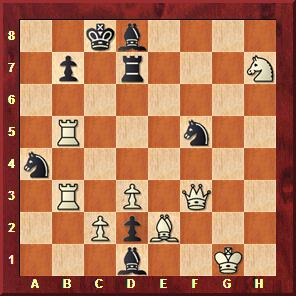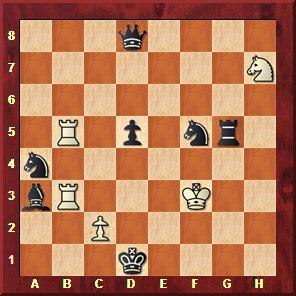Recomposition Contest Result
By Azlan Iqbal, Ph.D.
As part of the ChessBase Christmas puzzle series at the end of 2015, I
submitted
a new type of puzzle called, ‘recompositions’. The idea
here is to ‘recompose’ the original starting position given
just fragments of information such as the moves (in coordinate notation)
and perhaps an engine evaluation score of that line. ChessBase readers were
tasked with some detective work in finding the original starting position
that made the most sense.
From all the submissions I received, none actually solved the problem satisfactorily,
but one came quite close such that even I used it as a different starting
point to experiment with a viable solution. Alas, that solution still remains
elusive, and perhaps always will. In any case, the submission in question
is therefore in my view still worthy of the featured prize. Here it is,
compared to my own original solution (which admittedly did not work).

My original proposed solution |
|

The winner’s solution, by Koen
Eeman
|
As you can see, the position has been altered considerably. Notably, the
black king has moved a great distance to the other side of the board, and
the bishop on d8 has been replaced with a queen. The pair of white rooks,
however, remains the same as is probably also in the actual starting position
(whatever that may be). The winner apparently used the Stockfish 6 engine
and his solution corresponds to the original variation I provided until
about move 3 of the line. Instead of 3. ... Nh4, the main line shown for
his position is 3. ... Nc3 and it differs totally from there. Also, it appears
to be a forced mate for Black! So the solution only goes so far.

[Event "Forensic Chess"] [Site "?"] [Date "2016.01.28"] [Round "?"] [White
"Eeman, Koen"] [Black "Recomposition problem"] [Result "0-1"] [SetUp "1"]
[FEN "3q4/7N/8/1R1p1nr1/n7/bR3K2/2P5/3k4 w - - 0 1"] [PlyCount "20"] [EventDate
"2016.??.??"] [SourceDate "2016.01.28"] {Recomposition from the move sequence:
1. h7g5 d8g5 2. b5d5 d1c2 3. b3a3 f5h4 4. f3e4 g5e7 5. e4f4 e7a3 6. d5b5
a3d6 7. f4g5 a4c3 8. g5h4 c3b5 9. h4g5 d6e5 10. g5g6 c2d3} 1. Nxg5 Qxg5
2. Rxd5+ Kxc2 3. Rxa3 Nh4+ 4. Ke4 Qe7+ 5. Kf4 Qxa3 6. Rb5 Qd6+ 7. Kg5
Nc3 8. Kxh4 Nxb5 9. Kg5 Qe5+ 10. Kg6 Kd3 0-1
The winner, from what I understood, also posited the idea that the line
I provided (with a score of +8) may have been an incomplete evaluation at
the time it was cut off (assuming it was cut off). This is possible but
yet a far cry from Black forcing mate. In any case, congratulations to our
winner! I played around with the pieces and Stockfish 6 myself and could
not make further progress from his solution so it remains the closest one
thus far.
Nevertheless, here is a new challenge where I actually know the original
position, so potential solutions can be compared against it for accuracy.
The engine analysis for this line is +9.99. Good luck!
1. h2e5 e3c5
2. h1g2 f5g5
3. d5d6 g5g6
4. d6d7 g6g8
5. f6f7 g8f8
6. d7d8 f8d8
7. c6d8 e2c4
8. g2c6 b5a5
9. d2d3 c4f7
10. d8f7 a5b6
You can send your solutions to my
official email address with a c.c. to my
private address, just in case our spam filter here at the university
gets too fussy.

Koen Eeman wins this copy of Fritz 13, signed
by Garry Kasparov.
A similar prize awaits the winner of the new problem.
Previous ChessBase articles by Prof. Azlan Iqbal
-
12/29/2015 – ChessBase
Chrismas Puzzles 2015 (5)
Here's an interesting problem: say you have found some moves somewhere,
in coordinate notation without piece names – e.g. 1.h7g5 d8g5
2.b5d5 d1c2 etc. Can one reconstruct the original supposedly meaningful
position to which they apply? Azlan Iqbal, who has a Ph.D. in artificial
intelligence, retraces his thought processes when he tried, in this
unique exercise in forensic chess. Help him and you can win a special
prize.
-
5/31/2015 – Celebrating
300 machine generated problems
As we reported before, Chesthetica, a program by Azlan Iqbal, is autonomously
generating mate in three problems by the hundreds, and the author is
posting his selections in a very pleasing format on YouTube. The technology
behind the program’s creativity is a new AI approach and Dr. Iqbal
is looking for a substantial research grant for applications in other
fields.
- 4/7/2015 – Switch-Side
Chain-Chess Revisited
The search continues for a chess variant which retains the flavour of
the original game but does not succumb to the brute calculating power
of modern computers. AI researcher Azlan Iqbal has proposed his own unique
variant. Now he provides some test games and shows how Carlsen could have
won (instead of lost) WCCh Game 3 against Anand in Sochi had Switch-Side
rules applied.
-
2/6/2015 – Computer
generated chess problems for everyone
Now they are composing problems that fulfil basic aesthetic criteria!
Chesthetica, a program written by Azlan Iqbal, is churning out mate
in three constructs by the hundreds, and the author is posting them
in a very pleasing format on Youtube. How long will Chesthetica theoretically
be able to generate new three-movers? Quite possibly for tens of thousands
of years.
-
11/7/2014 – A
machine that composes chess problems
Chess problems are an art – positions and solutions, pleasing
to the mind and satisfying high aesthetic standards. Only humans can
compose real chess problems; computers will never understand true beauty.
Really? Dr Azlan Iqbal, an expert on automatic aesthetic evaluation,
imbued his software with enough creativity to generate problems indefinitely.
The results are quite startling.
-
7/26/2014 – Best
‘Chess Constructs’ by ChessBase readers
Chess constructs are basically an intermediate form of composition or
chess problem, lying somewhere between brilliancies from chess history
– and artistic chess problems, between real game sequences and
traditional award-winning compositions. A month ago Dr Azlan Iqbal explained
the concept asked our readers to submit compositions of their own. Here
are the winners.
-
6/29/2014 – Azlan
Iqbal: Introducing ‘Chess Constructs’
People love brilliancies from chess history – and artistic chess
problems. But there is a big gap between the two. Positions from games
demonstrate the natural beauty of actual play, while chess problems
are highly technical, with little practical relevance. The author of
this interesting article suggest an intermediate form, one you can try
your hand at – and win a prize in the process.
-
9/2/2009 – Can
computers be made to appreciate beauty?
Or at least to identify and retrieve positions that human beings consider
beautiful? While computers may be able to play at top GM level, they
are not able to tell a beautiful combination from a bland one. This
has left a research gap which Dr Mohammed Azlan Mohamed Iqbal, working
at Universiti Tenaga Nasional, Malaysia, has tried to close. Here's
his delightfully interesting PhD thesis.
-
12/15/2012 – A
computer program to identify beauty in problems and studies
Computers today can play chess at the grandmaster level, but cannot
tell a beautiful combination from a bland one. In this research, which
has been on-going for seven years, the authors of this remarkable article
show that a computer can indeed be programmed to recognize and evaluate
beauty or aesthetics, at least in three-move mate problems and more
recently endgame studies. Fascinating.
-
2/2/2014 – A
new, challenging chess variant
Ever since desktop computers can play at its highest levels and beat
practically all humans, the interest of the Artificial Intelligence
community in this game has been sagging. That concerns Dr Azlan Iqbal,
a senior lecturer with a PhD in AI, who has created a variant of the
game that is designed to rekindle the interest of computer scientists
– and be enjoyable to humans as well: Switch-Side Chain-Chess.
- 5/11/2014 – Kasparov
in Malaysia
He was mobbed, but in a good way: a large number of chess fans and autograph
hunters sought close contact to the legendary World Champion, who officiated
the opening of the PMB National Age Group Championship 2014, and took
time to discuss a variety of topics with an expert on aesthetics-recognition
technology in chess, our author Dr Azlan Iqbal – who sent us a big
pictorial report.



























